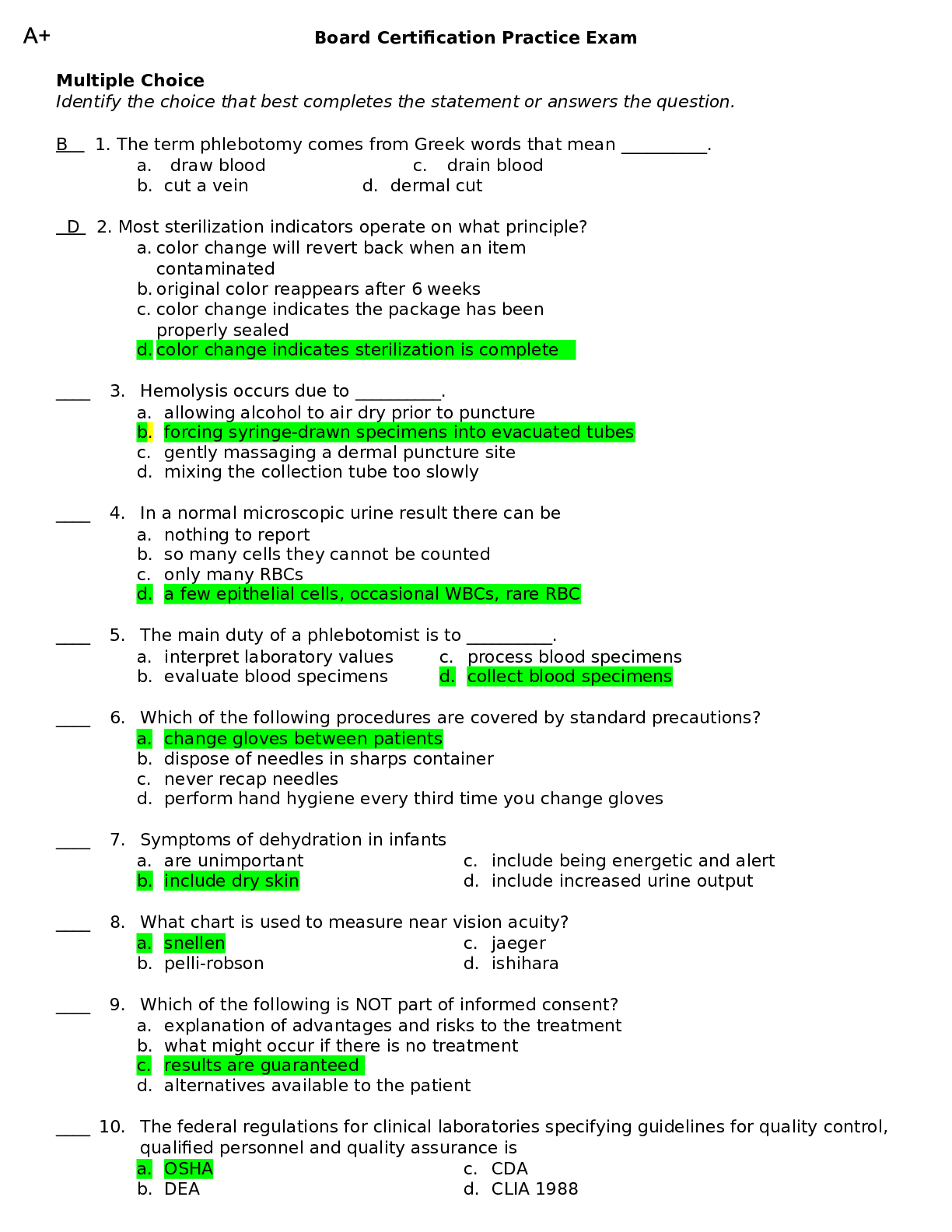*NURSING > AQA QUESTION and MARK SCHEMES > PracticeExam_CCMA(NHA)_Question (All)
PracticeExam_CCMA(NHA)_QuestionMultiple Choice Identify the choice that best completes the statement or answers the question. B 1. The term phlebotomy comes from Greek words that mean __________. a ... . draw blood c. drain blood b. cut a vein d. dermal cut D 2. Most sterilization indicators operate on what principle? a. color change will revert back when an item contaminated b. original color reappears after 6 weeks c. color change indicates the package has been properly sealed d. color change indicates sterilization is complete ____ 3. Hemolysis occurs due to __________. a. allowing alcohol to air dry prior to puncture b. forcing syringe-drawn specimens into evacuated tubes c. gently massaging a dermal puncture site d. mixing the collection tube too slowly ____ 4. In a normal microscopic urine result there can be a. nothing to report b. so many cells they cannot be counted c. only many RBCs d. a few epithelial cells, occasional WBCs, rare RBC ____ 5. The main duty of a phlebotomist is to __________. a. interpret laboratory values c. process blood specimens b. evaluate blood specimens d. collect blood specimens ____ 6. Which of the following procedures are covered by standard precautions? a. change gloves between patients b. dispose of needles in sharps container c. never recap needles d. perform hand hygiene every third time you change gloves ____ 7. Symptoms of dehydration in infants a. are unimportant c. include being energetic and alert b. include dry skin d. include increased urine output ____ 8. What chart is used to measure near vision acuity? a. snellen c. jaeger b. pelli-robson d. ishihara ____ 9. Which of the following is NOT part of informed consent? a. explanation of advantages and risks to the treatment b. what might occur if there is no treatment c. results are guaranteed d. alternatives available to the patient ____ 10. The federal regulations for clinical laboratories specifying guidelines for quality control, qualified personnel and quality assurance is a. OSHA c. CDA b. DEA d. CLIA 1988 A+ ____ 11. The slowly degenerative brain disease that leads to tremor, muscle rigidity, difficulty moving and instability is a. parkinson’s disease c. stroke b. alzheimer’s disease d. glaucoma ____ 12. Which of the following procedures would help diagnose an infection with a blood parasite? a. blood cultures c. bleeding time b. blood smear d. cold agglutinins ____ 13. Bacteria require which of the following to grow? a. disinfectants c. light b. cool temperature d. moisture ____ 14. An illuminated instrument used to examine the ear is an __________. a. ophthalmoscope c. otoscope b. anoscope d. cystoscope ____ 15. A physician’s license may be revoked or suspended for the following reasons __________. a. conviction of a crime c. unprofessional conduct b. fraud d. all of the above ____ 16. The documentation of all clinical laboratory tests and results is important so a. the physician can use the results b. any interested party in the facility can see the results c. results are available for billing purposes d. lab director can monitor the amount of work load ____ 17. The presence of which of the following in urine may signal the onset of diabetes mellitus? a. leukocytes c. ketones b. glucose d. nitrates ____ 18. The rule to calculate a woman’s due date for delivery is __________. a. the rule of nine c. naegle’s rule b. snellen chart d. clark’s rule ____ 19. The causative agent for syphilis is __________. a. treponema pallidum c. staphylococcus aureus b. streptococcus pyogenes d. trichomonas vaginalis ____ 20. During normal heart activity, __________ is the primary pacemaker. a. bundle of his c. AV node b. SA node d. AV junction ____ 21. A plastic red-topped tube contains __________. a. an anticoagulant c. a clot activator b. an antiglycolytic agent d. no additives ____ 22. Which of the following is the usual site for capillary puncture in infants? a. fingertip c. heel b. earlobe d. toe ____ 23. Which of the following is a reason to have an ECG? a. detects myocardial ischemia c. ev [Show More]
Last updated: 2 years ago
Preview 1 out of 13 pages

Buy this document to get the full access instantly
Instant Download Access after purchase
Buy NowInstant download
We Accept:

Can't find what you want? Try our AI powered Search
Connected school, study & course
About the document
Uploaded On
Apr 06, 2023
Number of pages
13
Written in
All
This document has been written for:
Uploaded
Apr 06, 2023
Downloads
0
Views
67
Scholarfriends.com Online Platform by Browsegrades Inc. 651N South Broad St, Middletown DE. United States.
We're available through e-mail, Twitter, and live chat.
FAQ
Questions? Leave a message!
Copyright © Scholarfriends · High quality services·